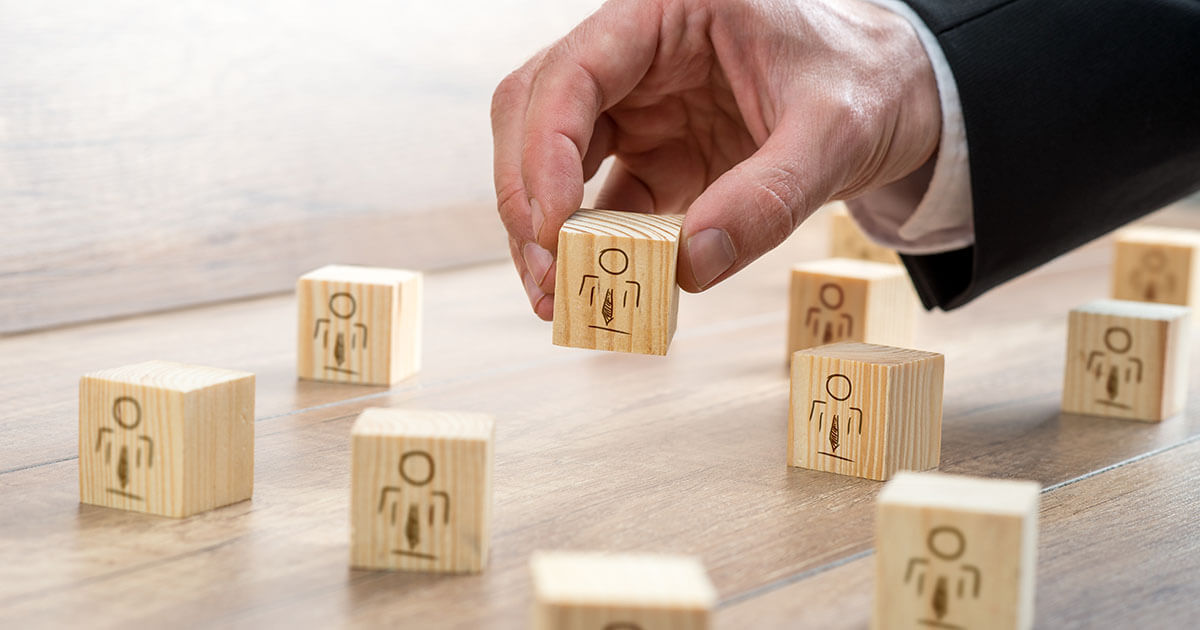Body language: The most important form of nonverbal communication
Language is deceptive. A person can say one thing and mean something entirely different or intentionally mislead another person through lies. But misleading someone with their body language is much more difficult, since a big part of it happens subconsciously. Through someone’s gestures, facial expressions, and posture, you’re able to read into how a person is feeling. You only have to understand the signs.
If you’re capable of interpreting body language correctly you’ll have a huge advantage when it comes to communicating with others. It means you’re able to level with someone’s emotional state and can more easily create an atmosphere of trust. This applies to both private and professional life. At the same time, understanding others’ nonverbal signals is only the first step to adjusting your own body language accordingly. It’s not about knowingly deceiving others, but about coming across in an authentic and confident way.
What is body language? Definition and meaning
Body language is the most important form of nonverbal communication, as facial expressions, gestures, and posture are usually a direct expression of how we feel. That’s because we send most of these signals subconsciously. Especially in emotional situations when we’re happy, scared, angry, or sad it’s almost impossible to hide this.
Body language includes all conscious and subconscious signals that our body sends out and gives something away about our emotional state. This includes nonverbal statements or gestures, expressions, posture, and movements. Sign language doesn’t count towards this, as it’s a form of learned expression in our language system.
However, there are also conscious signals that can be used in a very targeted manner. Hand gestures can help emphasise our arguments, and facial expressions can signal openness for a conversation or the desire to be left alone.
Subconscious and conscious body language
Exhaling impatiently, rolling your eyes, an offended pout – these signals give away our emotions, even if they only last for a fraction of a second. And these signals can be read in the same subconscious way as they’re sent out. That’s why we don’t like certain people at first glance or are instantly excited to see someone, without really being able to say why that is. We pick up on body language in passing, while we concentrate on what’s being said or while letting our mind do all the work.
But besides subconscious body language we also send out conscious body signals. This is language that we’re trained to understand and is conditioned by our cultural surrounding. We apply it in suitable situations, to send a certain message, or to underscore what we’re saying. Typical examples of this include the raised index finger for “Attention!”, the thumbs up for approval, or open hands to cool down a situation or to appease emotional breakouts. But you should act with caution, as body language is always read within a cultural context. A certain hand gesture can have an entirely different meaning on another continent or in different cultural circles.
Body language meaning
Body language has a strong influence on how people come across and how statements are picked up on. Just look at photos or video recordings of famous speeches. You’ll clearly see that not only the contents of the speech affect its success, but also if it is presented in a dynamic way. Body language tells listeners how important the topic is to the speaker, making it an essential criterion for credibility.
But it’s also in our direct private and professional environments that people are judged based on their body language. Nothing is more confusing than a colleague that’s explaining how excited he is about an assignment with a blank look on his face, or a manager who restlessly scans the room while mumbling how fascinated he is by an idea. These examples show us that body language is something we are continuously looking to understand and that, often, it even reflects the attitude of someone more authentically than their words. A significant discrepancy between someone’s words and body language will undoubtedly anger or annoy the person you’re speaking to.
But as already mentioned, you should be careful about consciously making use of body language in intercultural situations, because these signals don’t have the same meaning in different parts of the world. On the other hand, it lets you communicate even if you don’t speak the same language. This applies especially to those more instinctively used facial expressions and gestures that are universally understood, as they connect with humans’ underlying emotions. A smile, for example, is understood as a sign of openness and friendliness almost everywhere. For all other gestures, its best to first inform yourself on its meaning within a given cultural context. In Europe, a thumbs up is usually a sign of approval – but in Australia it can be a terrible insult.
In communication studies, the study of kinesics and the how we move our bodies when communicating is explored. It looks at the effects that expressions, gestures, and posture have in special situations like in sales conversations, contract negotiations, or de-escalation efforts. The things we learn through the study of kinesics are applied, for example, in training courses for sales personnel, mediators, speakers, and social workers.
Body language examples
Understanding body language and its signals plays an important role in everyday communication, and it is defined by a person’s facial expressions, gestures, posture, and body movements. The huge influence that tiny motions have on our emotions is demonstrated in the below examples.
Facial expression
Facial expression includes all movements that can be read in a person’s face. One of the most important signals of all is smiling. It lets us communicate openly with strangers, signals friendliness, empathy, and joy, and is the perfect addition to a conversation.
Emotions are very much communicated through our eyes and emphasised through the mouth and other facial movements. One look alone can signal interest, absence, affection, hate, distrust, curiosity, or fear, and all this can be read in a fraction of a second.
- Interest/curiosity: Your eyes are wide and calmly looking at the person you’re speaking to or the item you’re talking about, showing that you’re concentrated and taking in information. But beware: If eye contact lasts too long others can quickly feel uncomfortable.
- Disinterest: Your gaze wanders through the room and stops at different people and movements. A totally unfocused, motionless stare is a sign that someone has retreated and is hung up in their thoughts.
- Surprise: Your eyes open up wide and eyebrows are raised.
- Rage/anger: Your eyes are narrowed as are the eyebrows and a frown is visible.
- Doubt: Your gaze is concentrated, but your eyes are restless, because the listener is wondering whether to believe you. Depending on posture, eyebrows can be raised in amazement or can be pulled together in annoyance.
- Fear: With fear, too, the eyes are pulled wide open – at the same time the pupils are wide, to take in all details of the threat.
If you want to really understand body language, then you should pay attention to the pupils. They are very revealing, as their movements are not consciously controlled, but nonetheless clearly mirror emotions. When someone is excited, the pupils widen with excitement; with fear or disgust, they get smaller.
Gestures
Brain researchers have discovered that the areas of the brain in charge of memory and processing thoughts and those in charge of controlling movement are directly adjacent. This explains why many people gesticulate when they speak, even if they’re on the telephone and no one can see them. Gestures help us to organise our thoughts and to create references to remember them better. These processes all happen subconsciously, and are very different to the actively used gestures of trained speakers, politicians, and actors.
Beyond this, there are also gestures that we learn in the course of our lives, which serve to underline verbal utterances:
- Welcome: Wide open arms that invite a hug, or an outheld hand that can be seen from afar both show excitement to see a person.
- Defence: Stretched out hands to the sides with held up palms, turned towards another person, means that you are defending yourself. It signals that the other person shouldn’t come any closer.
- Anger: Forming a fist shows that a person is trying to control themselves. If the fist is raised, it shows a threat of violence.
- De-escalation: The hand movements might be the same as in a defensive stance, but here the arms are not stretched out but kept close to the body. This gesture means you are trying to calm someone down and signals that they shouldn’t be afraid.
- Helplessness/ignorance: If someone doesn’t know how to deal with a situation, then this is shown by repeatedly pulling up the shoulders.
These are just a few examples that demonstrate how hand gestures are used in day-to-day communication. This kind of body language is used by all people of a culture in the same way.
Body language and movement
Posture is a clear indicator of a person’s emotional state. That’s why it’s said that happy people “glide through life,” while sad people shuffle along with low shoulders and a sunken head. A person’s confidence can also be picked up from a person’s body language. If your boss walks through the office with a raised chin, an arched chest, and wide steps, it’s clear that they are confident in their role and regard themselves as a leader. Hasty, nervous movements like picking at your clothing or hair, or rocking your feet while sitting at the tip of the chair, on the other hand, signal uncertainty and give the impression that you want to escape the situation.
Movement
The examples mentioned above prove that posture and movements are difficult to keep apart. A certain posture requires a certain movement. It’s unlikely that a person with a proud, upright posture will walk timidly, and it’s unlikely that a person with a slumped posture will be walking down a street in fast, big strides.
Beyond this, there are certain movements that carry direct messages. An example of this is overstepping an appropriate distance to another person. The specific point at which this becomes uncomfortable very much depends on the individual. In general, acquaintances that we’re friendly with are allowed relatively close. But between strangers, and especially with superiors, distance is a sign of respect. If someone comes too close, it can be regarded as threatening or degrading. In any case, it means you’re crossing a boundary, which only in rare cases causes a positive reaction.
Using body language at work
Having looked at various forms of body language with examples, it’s time to look at how to apply this knowledge to communication in the workplace. In professional life, understanding and using body language belongs to the communicative soft skills of an employee.
Even during the job interview, body language plays an essential role. The time for both parties to make an impression is limited, which is why nonverbal signals are used above average during this mutual evaluation – since you can only talk about professional skills, but not really get a realistic picture of them.
For applicants, it’s important to make a sovereign and confident, but not overbearing, impression. That’s why you should be aware of what your nervous gestures give away, for example by asking family and friends. For example, if you’re always playing around with your hair or plucking at your beard, you could try crossing your arms in your lap. During the conversation, you should be sitting in a calm but upright position. If you’re leaning back with crossed legs on a chair, you might come across as disinterested and unmotivated.
If you’re the one taking the interviews on the other hand, you should focus on sending out positive signals to help create a calm environment and calm the applicant’s nerves. You can achieve this through friendly gestures and occasional questions. If you have any criticism, then it’s best to not directly confront the applicant with this, but to use the proven sandwich method, whereby you sandwich criticism in between positive aspects.
A further common situation in which body language plays an essential role are negotiations. Whether a contract negotiation with a client or with your boss: These conversations usually imply that both parties have different views and must find a compromise. The previously mentioned aspects concerning job interviews equally apply here. But beyond this, you can make use of targeted gestures in this kind of situation, to show that you sympathise with the other person’s views but also to clearly bring your own points across.
A proven strategy is the so-called mirror method, whereby you – discreetly – mirror some of your counterpart’s gestures, signalling that you’re on the same page and can relate to their “counterview.” If you sense that the conversation might be in danger of slipping into a heated discussion, a change in seating can help calm down the situation. If, for example, you’re sitting across from one another to start, you could choose to sit beside your negotiation partner, should there be enough space to do so. This signals that both parties are working towards the same goal, but just have to decide on the path there.
Should you already find yourself in the midst of a discussion, then calming gestures, like holding out one or both open palms (without a defensive posture) or the calm lowering of your hands, can soften a situation.
However, you shouldn’t let yourself derail too much from your goal, which you should clearly bring across, should the situation allow it. Crossing your arms – a gesture you should generally avoid during direct conversation – here becomes a sign that your pain threshold has been reached and that you won’t budge from your demands.
Whichever strategy you choose, it’s important that you don’t let your emotions get the best of you and that you always listen to your intuition on which signals are appropriate and helpful. Then, you’ll be able to strategically use body language to your advantage.
Please note the legal disclaimer relating to this article.




